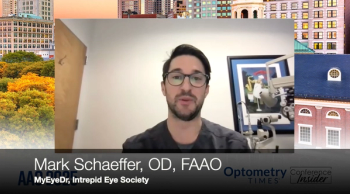
Five myths about scleral lenses debunked
Scleral lenses have gained popularity in the last decade. From a lens with limited viability for over 100 years to the fastest growing segment of the gas permeable lens market, scleral lenses have come a long way.
Scleral lenses have gained popularity in the last decade. From a lens with limited viability for over 100 years to the fastest growing segment of the gas permeable lens market, scleral lenses have come a long way. Yet there is still some hesitance on the part of many practitioners to fit or recommend them, and some misconceptions about scleral lenses may be holding back individuals who might otherwise be offering them to the benefit of many patients.
I wanted to explore what I felt were five myths about scleral lenses and how getting past these myths might help some practitioners begin to embrace sclerals and incorporate them into their practices.
Myth 1: Sclerals are hard to fit
Many practitioners look at the size of a scleral lens and assume that it must be hard to fit. Practitioners already feel like fitting corneal
Scleral lenses do require a slightly different way of thinking than other lenses. Instead of thinking in terms of curves, it is helpful to think in terms of depth or clearance. Once we clear that hurdle, fitting sclerals can seems quite simple.
Fitting scleral lenses is a three-step process, and following this process each and every time will lead to success in a majority of patients.
Step one. Choose a lens with enough depth to clear the cornea entirely. Scleral lenses by definition do not touch the cornea. If you put a lens on the eye that touches the cornea, it is simply not deep enough. Moving to a lens with greater depth will eventually lead to a lens that clears the cornea entirely. Once you have achieved that clearance, you can get more specific and work on getting the exact amount of clearance you desire. This amount of clearance will be part of the fitting guide for the lens design you use, it but should be somewhere in the neighborhood of 150-450 µm.
Step two. Ensure the lens clears the limbus. A scleral lens that bears on the limbus will eventually lead to problems with dryness, redness, and discomfort. You can tell if there is limbal clearance by looking for the fluorescein under the lens to extend beyond the limbal area (Figure 1). If you do not have limbal clearance, it is as simple as asking your lab consultant to make the lens with more clearance.
Step three. Make sure the lens bears evenly on the sclera. Thankfully, the sclera is a very forgiving layer of tissue. Lenses that are too flat on the edge will have edge standoff. Lenses that are too steep on the edge will compress the blood vessels of the conjunctiva and create blanching. Lenses that are too flat or steep in one meridian only will require a toric landing zone. Modifying the landing zone is usually as easy as asking for steeper, flatter, or toric landing curves.
Fitting a scleral lens is actually quiet straightforward because the sclera is more forgiving than the cornea. If the idea that fitting scleral lenses is difficult is what is holding you back, you are falling prey to Myth 1.
Myth 2: Sclerals are expensive
Relative to corneal GP lenses, scleral lens are expensive. But, relative to a year’s supply of hybrid or soft lenses, there is much less difference. When considering that for many patients the scleral lens provides better comfort and wear than a corneal GP and better vision than a soft, the cost should not often be a concern.
I have fitted hundreds of individuals in scleral lenses, and the cost aspect has been a sticking point for only a small percentage of them. Once they have had the opportunity to try on a lens, feel the comfort, and see the vision, the price of the lens becomes secondary. In many instances in which corneal irregularity or ocular surface disease exist, scleral lenses can be covered by insurance. In cases where the lenses are used for refractive error only, charge the cash pay patient a reasonable amount to make the lenses and the fitting process worthwhile financially for the office, but still keep the cost to the patient affordable.
Myth 3: Sclerals are a lens of last resort
This has been the reality for most of the history of scleral lenses, but it is changing as more practitioners realize they are easy to fit, provide good vision, good comfort, and can be affordable. There was a time as recently as 1991 when a survey reported that GP lenses comprised nearly 40 percent of the contact lens fits in the UK.1
Certainly there was a time when we as a profession were very comfortable fitting GP lenses on a substantial percentage of our patients who wanted correction for refractive error with contact lenses. If scleral lenses are more comfortable than corneal GPs and correct the vision as well, could we return to a time when we were increasingly comfortable using scleral lenses for correcting simple refractive error?
Scleral lenses can be used to correct any type of refractive error, as well as presbyopia (Figure 2). Athletes who require excellent acuity and a stable lens fit while they are physically active could benefit from scleral lenses. Individuals with nystagmus would benefit from the stable optics as well as the quality of vision provided by a scleral lens for the high prescriptions that often accompany it. Mild to moderate dry eye sufferers who desire contact lens correction may do better in sclerals than other contact lens options.
In addition, the use of scleral lenses for managing ocular surface disease could certainly be greater because there are no doubt thousands of individuals who would benefit from scleral lenses if only they were made aware of the power of the lenses to help manage their conditions. There is a substantial percentage of the eyecare community who do not fully understand the applications of scleral lenses for managing ocular surface disease until every other option has been tried and failed.
If scleral lenses were implemented at an earlier stage of the management of these ocular surface disease patients, such patients might find relief more quickly. This comes down to education of the eyecare community-including optometrists, ophthalmologists, and the medical community that works with individuals with systemic diseases that lead to ophthalmic effects-and the willingness to refer for or implement scleral lenses much earlier in the process of managing eye disease.
Myth 4: Sclerals are a niche lens for a small population of patients
This myth goes back to the previous point. Right now, scleral lenses are a niche lens for a small population of patients, but that is up to us as practitioners to make them more of a mainstream option. As mentioned previously, GPs made up a substantial percentage of contact lens wearers as recently as 25 years ago.
The reason for the shift was most assuredly comfort for the vast majority of those who converted from GP to soft lenses or those who chose soft lenses over GPs from the outset. Now that the comfort gap has been bridged by sclerals, the percentage of individuals in contact lenses who are candidates for reintroduction to GP lenses is significantly more than it was in the recent past.
The idea that sclerals are a niche lens is only a matter of what we as fitters make it. We have the option to make sclerals more mainstream if we choose.
Myth 5: We don’t know scleral lenses’ long-term effects on the eye
The final myth of scleral lenses is that we do not know the long-term effects on the eye, and this is true to a degree-it depends on what you consider long-term. Scleral lenses have been utilized in their current form for more than a decade, and for years before then on a limited scale by Boston Foundation for Sight and in other countries. To date, there has been little published that would indicate any long-term side effects to scleral lens wear.
Possible concerns have been for endothelial cell loss, increased intraocular pressure, or limbal stem cell or goblet cell damage from lens compression.
However, review of the scientific literature produces no studies that indicate any of these effects are observed across the board. Further studies will be conducted in these areas of potential concern, but after more than a decade of use and thousands and thousands of wearers, there is nothing that indicates long-term health is negatively impacted by wearing scleral contact lenses.
Fitting individuals in scleral contact lenses can be a rewarding professional experience. This experience can be yours as well if you look past the myths and start to embrace this new trend in GP lenses that looks like it will become a permanent and continually growing segment of the contact lens market.
Reference
1. Pearson RM. Contact Lens Trends in the United Kingdom in 1991. Cont Lens Anterior Eye. 1992:15(1);17-23.
Newsletter
Want more insights like this? Subscribe to Optometry Times and get clinical pearls and practice tips delivered straight to your inbox.



















































.png)


